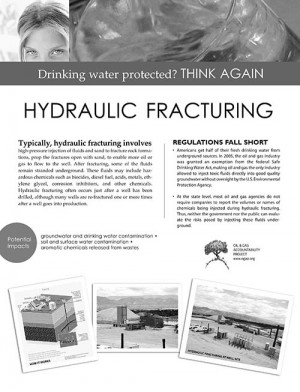Hydraulic Fracturing
Hydraulic fracturing is a common technique used to stimulate the production of oil and natural gas. According to the Interstate Oil and Gas Compact Commission, 90 percent of oil and gas wells in the U.S. undergo fracturing to stimulate production.
Fracking uses hazardous chemicals
Typically, fluids are injected underground at high pressures, the formations fracture, and the oil or gas flows more freely out of the formation. Some of the injected fluids remain trapped underground.
A number of these fluids, such as diesel fuel, qualify as hazardous materials and carcinogens, and are toxic enough to contaminate groundwater resources. Read more details in Earthworks' basic primer on hydraulic fracturing.
Unfortunately, despite the toxicity of these chemicals, a loophole in the Safe Drinking Water Act allows the drilling industry to keep them secret from the public -- even when doing so directly threatens human health.
Fracking threatens water quality
There are a number of cases in the U.S. where hydraulic fracturing is the prime suspect in incidences of impaired or polluted drinking water. In Alabama, Colorado, New Mexico, Virginia, West Virginia and Wyoming, incidents have been recorded in which residents have reported changes in water quality or quantity following fracturing operations of gas wells near their homes.
Read the Amos landowner story for an account of water contamination that occurred following hydraulic fracturing events. Also, Amy Mall's blog at NRDC keeps a fairly current list of incidents where hydraulic fracturing is suspected as the cause of drinking water contamination.
For more information:
- Earthworks: Hydraulic Fracturing 101
- Earthworks: Hydraulic Fracturing: Myths and Facts
- Earthworks: Inadequate regulation of hydraulic fracturing (including the Halliburton loophole)
Tagged with: hydraulic fracturing, fracking

Follow Earthworks